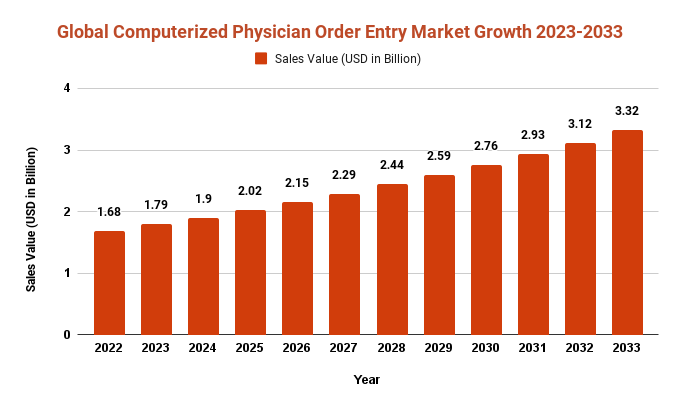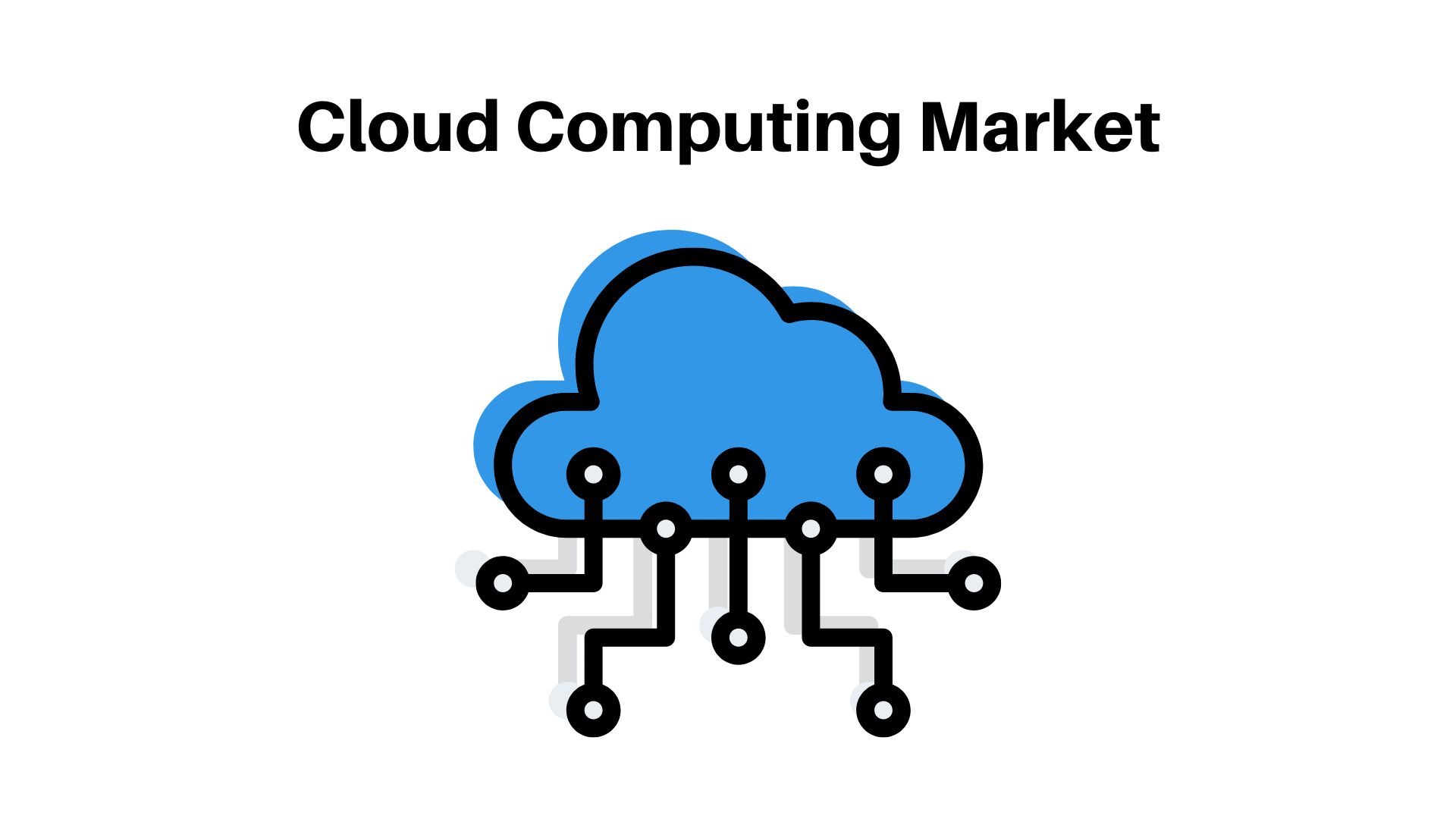Computerized Physician Order Entry Market Size To Reach USD 3.32 Bn By 2033

Page Contents
Market Overview
Published Via 11Press: Computerized Physician Order Entry Marketis an electronic platform that enables healthcare providers to electronically prescribe and oversee patient care. CPOE replaces paper-based systems and can help reduce medication errors while increasing patient safety. CPOE systems typically include features like drug databases, interaction alerts and allergy checks to ensure that medications prescribed to a patient are suitable and safe for them. They may also integrate with electronic health record systems (EHR) for a comprehensive view of their medical history including previous diagnoses, lab results and imaging studies.
The Computerized Physician Order Entry Market size is expected to reach USD 3.32 Bn by 2033, up from its current value of USD 1.68 Bn in 2022, growing at an annual compound growth rate (CAGR) of 6.39% from 2023-2033.
CPOE systems have been shown to increase patient outcomes, decrease medication errors, and enhance efficiency within healthcare settings. They are becoming an essential element of modern healthcare technology and increasingly adopted by hospitals and facilities worldwide.
Key Takeaways
- Computerized Physician Order Entry market is an electronic system that enables healthcare providers to prescribe and manage patient care electronically, replacing traditional paper-based systems.
- Computerized Physician Order Entry systems can drastically decrease medication errors and enhance patient safety, as they contain drug databases, interactions alerts and allergy checks to keep track of patient health.
- CPOE systems can integrate seamlessly with electronic health record (EHR) systems to offer an in-depth view of a patient's medical history.
- Computerized Physician Order Entry systems have been demonstrated to increase patient outcomes, reduce medication errors and enhance efficiency within healthcare environments.
- CPOE systems are increasingly being adopted by hospitals and healthcare facilities worldwide as an integral component of modern healthcare technology.
- It require careful implementation and ongoing maintenance to ensure their effectiveness and prevent unintended side-effects.

Request Sample Copy of Computerized Physician Order Entry Market Report at: https://marketresearch.biz/report/computerized-physician-order-entry-market/request-sample/
Regional Snapshot
Computerized Physician Order Entry (CPOE) adoption rates differ across geographic regions, with some countries more advanced than others in their implementation of CPOE technology. Here is an overview of adoption in various regions:
- North America: Adoption of CPOE has been quite high in both the United States and Canada, with hospitals and healthcare facilities having installed some form of CPOE system. Furthermore, the US government has encouraged its adoption through meaningful use programs.
- Europe: Adoption of CPOE across Europe has been relatively high, with most countries having implemented EHR systems with CPOE functionality; however, adoption rates vary considerably across nations.
- Asia: CPOE adoption in Asia is rapidly growing, with countries like Japan, South Korea, and Singapore implementing systems in numerous hospitals and healthcare facilities across their nations. Yet more implementation remains required across other Asian nations.
- Latin America: Adoption of CPOE systems remains low in Latin America, with only a handful of countries having widely implemented these systems. There have been efforts underway to expand adoption in countries such as Brazil and Mexico.
- Middle East and Africa: While adoption rates of CPOE remain relatively low in these regions, with many countries still using paper-based systems, initiatives are underway in countries like Saudi Arabia and United Arab Emirates to promote more widespread adoption.
Drivers
- Patient Safety: CPOE systems can assist in minimizing medication errors and increasing patient safety by offering real-time decision support and alerts about potential drug interactions, allergies or adverse events.
- Efficiency: CPOE systems can enhance healthcare delivery efficiency by automating prescription processes and eliminating paper orders, leading to faster turnaround times, fewer errors, and reduced costs.
- Compliance With Regulation: In some countries, such as the US meaningful use program, regulatory requirements may require healthcare providers to use CPOE systems as part of healthcare delivery.
- Increased Communication: CPOE systems can enhance communication among healthcare providers and result in improved coordination of care as well as enhanced patient outcomes.
- Data Analytics: CPOE systems offer rich sources of data for healthcare providers to use in conducting comprehensive analyses and research on trends, processes and outcomes.
- Integration With Electronic Health Records: CPOE systems can be seamlessly integrated with Electronic Health Record (EHR) systems, giving healthcare providers a comprehensive view of a patient's history while streamlining information exchange among healthcare providers.
Restraints
- Implementation Costs: Adopting CPOE systems can be costly, necessitating significant investments in hardware, software and training for healthcare providers – something which may present difficulties to smaller healthcare facilities with limited resources.
- System Complexity: CPOE systems can be complex and may require extensive customization in order to fit the unique requirements of healthcare facilities, which may result in delays during implementation and subsequent ongoing support and maintenance expenses.
- Resistance to Change: Healthcare providers may be reluctant to embrace change, particularly if they have become used to using traditional paper-based systems. This can result in low adoption rates and user dissatisfaction.
- Workflow Disruptions: Implementing CPOE systems may interrupt established workflows and cause confusion, delays and errors if not implemented effectively – leading to provider frustration and resistance towards adoption of these new tools.
- Technical Issues: CPOE systems depend heavily on hardware and software infrastructure, and technical problems like system downtime, connectivity issues or software bugs can severely undermine user adoption and satisfaction.
- Data Privacy and Security: Electronic health records and CPOE systems may cause concerns regarding data privacy and security, especially with an increasing threat from cybercrime and breaches. Healthcare facilities must ensure appropriate safeguards are in place to protect patient data.
Opportunities
Adopting Computerized Physician Order Entry (CPOE) systems offers healthcare providers many advantages, including:
- Improved Patient Safety: CPOE systems can enhance patient safety by reducing medication errors, providing decision support tools, and notifying healthcare providers of potential adverse events.
- Increased Efficiency: CPOE systems can increase healthcare delivery efficiency by automating prescription processes, eliminating paper orders and decreasing turnaround times.
- Better Communication: CPOE systems can facilitate communication among healthcare providers, leading to more coordinated care and improved patient outcomes.
- Enhance Data Analysis: CPOE systems offer healthcare providers access to rich data for research and analysis, helping them detect trends, optimize processes, and enhance outcomes.
- Compliance With Regulators: In some countries, implementation of CPOE systems may be mandated by regulatory requirements, such as those laid out under meaningful use in the US. Adherence to such regulations can result in both financial incentives and penalties for their use.
- Integrating with Electronic Health Records (EHRs): CPOE systems can easily integrate with EHRs to provide an all-encompassing view of a patient's medical history and facilitate seamless information transfer among healthcare providers.
- Improved Workflow: CPOE systems can enhance workflow by standardizing processes, reducing errors, and encouraging collaboration among healthcare providers.
Challenges
- Resistance to Change: Healthcare providers may be resistant to new systems, particularly those which use paper-based processes. This can result in low adoption rates and user dissatisfaction.
- Implementation Costs: Implementation costs associated with CPOE systems can be costly, necessitating significant investments in hardware, software and training for healthcare providers – this may present significant difficulties to smaller healthcare facilities with limited resources.
- Complexity of the System: CPOE systems can be complicated and require extensive customization in order to fit the needs of various healthcare facilities, which may delay implementation as well as incur ongoing maintenance and support costs.
- Workflow Disruptions: Integrating CPOE systems can disrupt established workflows, leading to confusion, delays and errors if they're implemented improperly – leading to provider frustration and possibly resistance against adoption of such technology.
- Technical Issues: CPOE systems depend heavily on physical and software infrastructure, and any issues such as system downtime, connectivity issues or software bugs could have an adverse effect on user adoption and satisfaction.
- Data Privacy and Security: Electronic health records and CPOE systems can raise concerns regarding data privacy and security, particularly given rising cyber attacks and breaches. Healthcare facilities must take measures to protect patient data effectively.
- User Training: CPOE systems require extensive user training in order to minimize risks of errors and ensure proper use. Training may be costly and time-consuming, with ongoing refreshers needed as updates or changes occur in the system.
Market Segmentation
End User
- Ambulatory surgical centers
- hospitals
- laboratories
- clinics
- pharmacies
Category
- integrated CPOE
- standalone CPOE
Deployment
- web-based
- cloud-based
- on premise
Components
- hardware
- software
- Services
Key Players
- Philips Healthcare
- Cerner Corporation
- Athenahealth Inc.
- GE healthcare
- Medical Information Technology Inc.
- eClinicalWorks LLC
- Carestream Health
- Siemens Healthcare
- Allscripts.
Report Scope
| Report Attribute | Details |
| Market size value in 2022 | USD 1.68 Bn |
| Revenue forecast by 2033 | USD 3.32 Bn |
| Growth Rate | CAGR Of 6.39% |
| Regions Covered | North America, Europe, Asia Pacific, Latin America, and Middle East & Africa, and Rest of the World |
| Historical Years | 2017-2022 |
| Base Year | 2022 |
| Estimated Year | 2023 |
| Short-Term Projection Year | 2028 |
| Long-Term Projected Year | 2033 |
Recent Developments
- Artificial Intelligence (AI) and Machine Learning (ML) Integration: CPOE systems are increasingly being integrated with AI/ML technologies for decision support and automating repetitive tasks, such as medication dosage calculations.
- Mobile CPOE applications: These are becoming more prevalent, enabling healthcare providers to access and enter patient information from their smartphones or tablets for greater flexibility and efficiency.
- Interoperability: CPOE systems are being designed with interoperability in mind, to facilitate seamless information exchange with other healthcare systems such as electronic health records (EHRs) and pharmacy systems.
- Cloud-Based Solutions: Cloud-based CPOE systems have become more prevalent, providing more scalability, accessibility, and cost effectiveness than their physical counterparts.
- Enhance Data Analytics: Modern CPOE systems now feature more robust data analytics capabilities that provide real-time insight into clinical workflows and patient outcomes.
- Blockchain Technology: Some CPOE systems are employing blockchain technology to enhance data privacy and security while also facilitating secure sharing of patient information.
Key Questions
- What Is Computerized Physician Order Entry (CPOE)?
A: Computerized Physician Order Entry (CPOE) is a digital system designed to enable healthcare providers to electronically enter and manage patient care orders such as prescriptions, lab tests and radiology exams. - What are the advantages of CPOE systems?
mes mes Its mes Its Achieve improved patient safety, increased efficiency, improved communication between healthcare providers, enhanced data analytics capabilities for regulatory compliance integration with Electronic Health Records (EHRs), and improved workflow. - What are some of the challenges associated with implementing CPOE systems?
A: Some challenges associated with implementing CPOE systems include resistance to change, implementation costs, system complexity, workflow disruptions, technical issues, data privacy/security concerns as well as user training needs. - How are CPOE systems changing to address these challenges?
A: Modern CPOE systems are evolving in response to these obstacles by adopting artificial intelligence and machine learning technologies, mobile apps, interoperability solutions, cloud services with enhanced data analytics features and blockchain technology. - How can healthcare providers ensure successful adoption and implementation of CPOE systems?
A: Healthcare providers can ensure the successful adoption and implementation of CPOE systems by carefully managing the implementation process, offering user training and support, responding to user concerns and feedback, and continuously evaluating and optimizing the system to meet changing patient needs.
Contact us
Contact Person: Mr. Lawrence John
Marketresearch.Biz (Powered By Prudour Pvt. Ltd.)
Tel: +1 (347) 796-4335
Send Email: [email protected]
The team behind market.us, marketresearch.biz, market.biz and more. Our purpose is to keep our customers ahead of the game with regard to the markets. They may fluctuate up or down, but we will help you to stay ahead of the curve in these market fluctuations. Our consistent growth and ability to deliver in-depth analyses and market insight has engaged genuine market players. They have faith in us to offer the data and information they require to make balanced and decisive marketing decisions.



